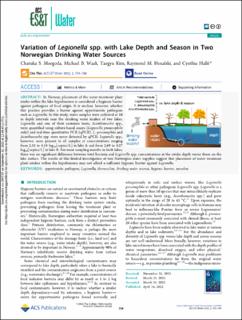Variation of Legionella spp. with Lake Depth and Season in Two Norwegian Drinking Water Sources
Peer reviewed, Journal article
Published version
Permanent lenke
https://hdl.handle.net/11250/3022029Utgivelsesdato
2022Metadata
Vis full innførselSamlinger
- Publikasjoner fra CRIStin - SINTEF AS [5802]
- SINTEF Community [2248]
Originalversjon
10.1021/acsestwater.1c00454Sammendrag
In Norway, placement of the water treatment plant intake within the lake hypolimnion is considered a hygienic barrier against pathogens of fecal origin. It is unclear, however, whether this practice provides a barrier against opportunistic pathogens such as Legionella. In this study, water samples were collected at 10 m depth intervals near the drinking water intakes of two lakes. Legionella and one of their common hosts, Acanthamoeba spp., were quantified using culture-based assays (Legionella pneumophila only) and real-time quantitative PCR (qPCR). L. pneumophila and Acanthamoeba spp. were never detected by qPCR; Legionella spp., however, were present in all samples at concentrations ranging from 2.33 to 4.14 log10[copies/L] in lake A and from 2.69 to 4.27 log10[copies/L] in lake B. For most sampling months in both lakes, there was no significant difference between total bacteria and Legionella spp. concentrations at the intake depth versus those on the lake surface. The results of this limited investigation of two Norwegian water supplies suggest that placement of water treatment plant intakes within the hypolimnion may not afford a sufficient hygienic barrier against Legionella.

